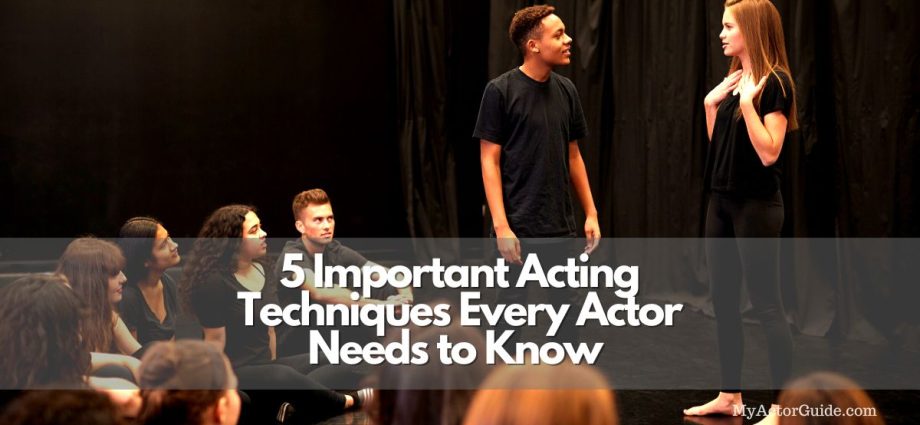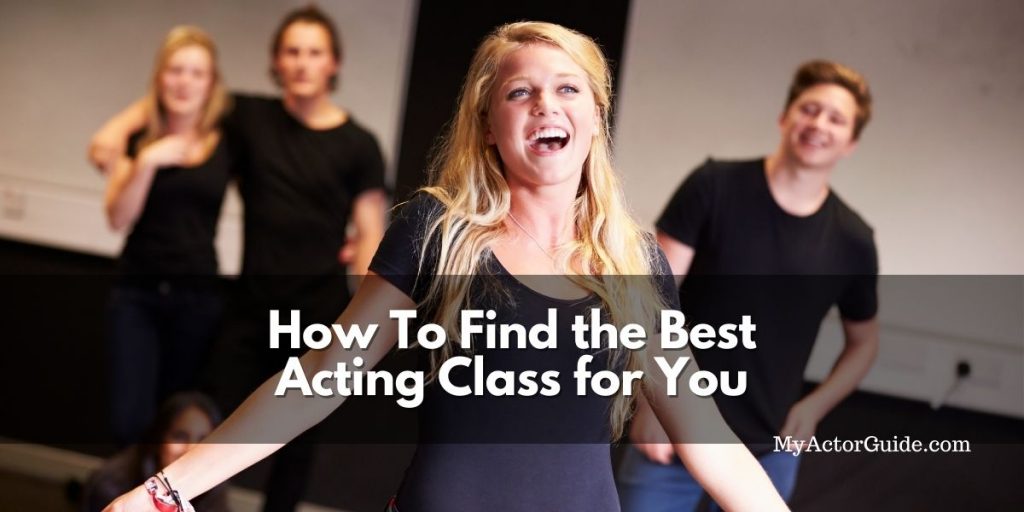This post may contain affiliate links, so I may receive a commission, at no cost to you, if you make a purchase through a link. Check out the disclosure for more info. And thank you for supporting free content!
What makes an actor? How do you learn the skills – to act? And how do you become an actor? With most other professions there is a clear path for education, study and career development. But for acting it’s a little more complicated.
Acting, at it’s essence is art. It’s storytelling, creating and collaborating, and there is no one right way to do it. There are however a number of different schools of acting, or methods, also known as acting techniques. Often times you will hear A-list actors talk about their process and their preference of the acting techniques they use to prepare for and perform a role. And while I haven’t studied every single one, I have studied many. Some in-depth, and others just a taste. They are all valid. And they all compliment and accentuate each other. It’s simply a matter of finding what works for you, what speaks to you the most and what allows you to create and portray magnetic characters.
How do I find the acting technique that’s right for me?
Think of acting techniques as you would a fitness routine or practice. If you’re exercising regularly you’re going to see results. But does it matter if you do weight training, yoga, HIIT, pilates, CrossFit, running or tennis? Each one of them offers a notable benefit. Each one has a drawback. And each one will target a slightly different skillset. It’s a matter of finding what’s best for you and your body. Acting techniques are the same.
Why should I study specific acting techniques?
Trying to explain to someone how to do anything is difficult if you don’t have a system, particularly when it’s as subjective as acting. How do we define art and how do you explain to someone how to do it? This is where technique comes in. Over the years, acting techniques have been developed by a handful of passionate and creative actors to give other actors a system for approaching acting with it’s varied characters and roles.
Below I’ve broken these methods down and tried to give you an overview of the 5 fundamental acting techniques that every actor should know. I whole-heartedly encourage you to try out several and mix and match —rarely does an actor ever use just one style of acting for a particular role. As you learn the various tools that come with each method, you’ll develop your own rhythm and style. This is where it truly becomes art. Studying acting and acting techniques can be something that lasts a lifetime , and please, don’t feel pressured to try and do it all at once. Pick what speaks to you most right now and test the waters. Dive in, explore and enjoy!
Jump to:
Stanislavski Method
This is both a name and a method every actor should know. Konstantin Stanislavsky (spelled either Stanislavsky / Stanislavski ) was truly the founder of modern day acting. Many of the famous acting methodologies used by actors today have been derived from the work of Staninslavski, with his blessing, by his students and protégés.
At the time Stanislavsky developed his particular technique, he was the co-founder of the Moscow Art Theatre. His approach revolutionized the profession and art of acting and is the foundation of all modern methods of acting used today. Stanislavsky paid special attention to the whole human being and human behavior and forever changed the craft.
The Stanislavski system is much about “given circumstances”. The basis of it is behind the famous actor questions:
- Where am I?
- What’s going on?
- What are the circumstances?
- What time of day or night is it?
- Who am I? (specifically)
- What is my relationship to the other character(s)?
- What just happened? and
- What is the moment before?
Once you can answer these questions, you have a lot to work with! This really humanizes both the character, and the situation / scene you’re in.
With a deep focus on the emotional life of the characters, this system adds layers of depth and magic to the work, and to the pursuit of acting in general. Actors, as professionals, were suddenly elevated from more than just “pretend players” to sensitive intuitive human beings and experts in human behavior.
Stanislavsky encouraged actors to consider what they would do “if” they were in the circumstances of the characters they were playing.
Famous Staninslavski actors include:
James Dean, Ellen Burstyn, Al Pacino, Alec Baldwin, Marilyn Monroe, Paul Newman, Angelina Jolie, Scarlett Johansson, and Steve Buscemi.
Where can you study Stanislavsky’s techniques today?
I haven’t found anywhere that purely teaches the Stanislavski Acting Technique anywhere today, although this method is woven into almost every modern acting technique.
Books
If you want to learn more about Stanislavsky’s method you can read:
Stanislavski For Beginners, by David Allen
Meisner Technique
Meisner is probably one of the most famous techniques known amongst new actors – at least by name.
This approach to acting was developed by American actor Sanford (Sandy) Meisner while working with the Group Theatre in NYC alongside director Lee Strasberg and actress Stella Adler, both of whom were Stanislavski students.
The Meisner Technique is basically a series of exercises and and overall approach designed to “get actors out of their head” and act instinctively and intuitively based on impulse rather than a calculated series of moves. The three main components of the Meisner Technique include Emotional Preparation, Repetition, and Improvisation.
Known as a “real people” technique throughout the world of acting, the Meisner Technique trains actors to look like and act like “real human beings” in regular situations, with spontaneous facial expressions and gestures. (Lol! Right??!) This is something we are all familiar with and have come to expect now, but this wasn’t always the case.
Famous Meisner actors include:
Alec Baldwin, Diane Keaton, Stephen Colbert, Robert Duvall, Grace Kelly, Gregory Peck, and more.
As world renowned director Elia Kazan once said, “Take it from a director: if you get an actor that Sandy Meisner has trained, you’ve been blessed.”
Where can you study Meisner’s techniques today?
Meisner is a widely taught method. Every major city with acting studios is going to have someone teaching Meisner. Here are a few:
- New York: The Neighborhood Playhouse
- Los Angeles: The Sanford Meisner Center
- London: The London Meisner Company
Books
- Sanford Meisner on Acting **, by Sanford Meisner & Dennis Longwell
This book was written in collaboration with Dennis Longwell, and follows one of Sandford Meisner’s acting classes for fifteen months. The classes were recorded and this book is the result of those recordings. It begins with the most basic exercises and ends with polished scenes from contemporary American plays. It is essential reading for beginning and professional actors of any age.
- The Sanford Meisner Approach: An Actor’s Workbook, by acting coach Larry Silverberg
- The Actor’s Art and Craft: William Esper Teaches the Meisner Technique, by acting coaches William Esper & Damon DiMarco
The Method
At it’s core, Method Acting, or The Method, is a systematic approach to training actors to use “affective memory” or to emotionally recall and relive an event from your own life, and to use this emotional energy for the character and circumstance you are portraying right now.
Developed by Lee Strasberg, who was also one of Stanislavsky’s devotees, this approach is a highly controversial one given the obvious psychological implications of reliving heightened emotional memories, on stage in front of an audience. Strasberg believed it was never enough to recreate emotion on stage – you had to relive it.
Personally, I’ve tried Method Acting and have found it to be emotionally exhausting and sometimes just too overwhelming. Many times I have been left emotionally raw and basically a mess to be sorted out in more therapy sessions. There is a saying “better out than in”, but in today’s fast paced TV world, there is only so much you can do, and process, on-set. Ultimately you still have to take care of your own emotional well-being. I can see the value of this for deeply emotional movie roles where you have time to explore, but in TV Land when you have one day on set, and maybe only a few hours, it might not be your best choice.
Famous Method actors include:
James Dean, Ellen Burstyn, Al Pacino, Alec Baldwin, Marilyn Monroe, Julie Harris, Paul Newman, Steve Buscemi, Dustin Hoffman and Scarlett Johansson.
Where can you study Method Acting today?
The Lee Strasberg Institute offers classes both online and in-person in both New York and Los Angeles.
Books
A Dream of Passion: The Development of the Method, by Lee Strasberg
Stella Adler Technique
Stella Adler originally studied acting at Stanislavsky’s Moscow Art Theatre. Shortly after arriving in New York, she was asked to join The Group Theatre with Lee Strasberg. Ms. Adler felt that “affective memory” was far too torturous and emotionally harmed younger actors in the Group, so she traveled to Paris to ask Stanislavsky himself—and to prove Strasberg wrong. The two would go on to become rivals as she opposed Strasberg’s approach with vehement passion.
Adler’s technique revolves around an actor’s ability to imagine a character’s world. She believed that heavily relying on personal emotional memories severely limited an actor’s range. Her technique encourages actors to broaden their view of the world as a way to create compelling performances.
Part of the technique is to almost obsessively observe everyday life; the sounds, textures, colors, smells, everything you need to create detailed and realistic mental images in front of the camera or on stage. The premise is that when mental images are this detailed and nuanced, an actor can authentically express this to an audience and delivers an equally nuanced performance.
Adler, who was an apparently demanding teacher is said to have pushed her students to create imaginatively convincing moments. The lessons from her New York City studio have been well documented and she is often quoted. It is said that Stella Adler insisted that the imagination of the artist could be just as vivid as real life experiences and much safer emotionally to use.
Famous Stella Adler trained actors include:
Marlon Brando, Robert DeNiro, Benicio Del Toro, Mark Ruffalo, Melanie Griffith, Salma Hayek
“She was a tough, brilliant, beautiful teacher. She taught me everything.”
~ Marlon Brando on Stella Adler
Where can you study Stella Adler’s techniques today?
You can study Adler’s original methods in person at the Stella Adler Studios in either New York City or Los Angeles. The NYC studio also partners with NYU’s Tisch School for a BFA-granting program. Both offer in-person and online classes as well.
Books
If you want to take a deep dive into Adler’s techniques on your own, especially her style of script analysis, you can also read Stella Adler’s books:
- The Art of Acting, by Stella Adler
- Stella Adler on America’s Master Playwrights, by Stella Adler
- Stella Adler on Ibsen, Strindberg, and Chekov, by Stella Adler
Uta Hagen’s Technique
The teachings of Uta Hagen hold a special place in my life; I was lucky enough to get into one of her last Masterclasses before she passed away. She remains one of the most influential acting coaches of my life.
Uta Hagen’s acting techniques are based in realism, meticulous attention to detail and careful observation of daily activities and life. She encouraged actors not to over-intellectualizing the process, and instead root themselves firmly in the situation of the moment. This was done through a series of what has become her very famous “9 Questions”.
Uta Hagen’s original nine questions are:
- Who am I? – including name, age, physical traits, education, and beliefs.
- What time is it? Including season, the day of the week
- Where am I? – including country, town, neighborhood, room and even the specific part of the room. I.e we all have a favorite place to sit on the sofa 🙂
- What surrounds me? – including anything from weather to furnishings, to landscape, or people.
- What are the given circumstances? – including what has just happened, what is happening, and what does the character want to happen
- What are my relationships? – including relationships with other characters, the place, (ie. We feel very differently about where we work than our bedrooms) inanimate objects and even recent events.
- What do I want? – including what the character desires in the moment or overall if a movie, full TV episode or play
- What is in my way? – includes any and all obstacles the character must react to and/or overcome.
- What do I do to get what I want? – including physical action, tactics and emotional manipulations *note: Uta Hagen used “do” strictly relating to physical actions, however her teachings were primarily geared towards stage. In modern movies and TV, camera reads thought and we need to pay attention to the underlying “do” as well
Uta Hagen’s 9 Questions came from her first book, Respect for Acting. By the time I got around to working with her, she wasn’t a fan of her own first book and encouraged us to used the second one, A Challenge for the Actor, where she had revised and condensed the questions.
Famous Uta Hagen trained actors include:
Matthew Broderick, Faye Dunaway, Whoopi Goldberg, Sigourney Weaver, Jack Lemmon, Amanda Peet and David Hyde Pierce
Where can you study Uta Hagen’s techniques today?
Uta Hagen and her husband Herbert Berghof founded the H.B. Studio for Actors in New York in 1945. It is one of New York’s original acting studios and where Ms. Hagen taught until her death in 2004. They currently offer both online and in-person classes as well.
Books
If you want to take a deeper dive into Ms. Hagen’s techniques on your own, especially her detailed exercises, you can also read Uta Hagen’s books:
- A Challenge For The Actor, by Uta Hagen
- Respect for Acting, by Uta Hagen
* This is a 3 hour video of a full class! You’ll probably want to bookmark the video and make time to watch. Think of it like a free acting class from one of the greatest acting coaches of the twentieth century!
Important Techniques, Coaches and Classes for TV Actors
The techniques I’ve listed above are the core foundations that every actor should be familiar with. Having said that, there are many wonderful acting teachers and coaches today and new techniques that have come along that I would also highly recommend. Some of the most notable ones are: Second City – for comedy and improv, Upright Citizens Brigade – also comedy and improv, Scott Sedita’s Sitcom Technique and Larry Moss – who coached Hilary Swank and Helen Hunt to Oscar wins.
Was this article helpful? Like it, share it, post it, tweet it! Send it to an actor friend. It’s a tough business and everyone could use a little help!
Have a question? Head to the comments below. I answer every one!
* Please Note: I am not an agent, manager, or casting director. I do not procure work for actors. All information, workshops and coaching are for educational purposes only and are not a guarantee or promise of employment. Thank you for being here!







Thanks so much! really helpful
Yay! I’m so happy… just trying to make the journey a little easier 🙂